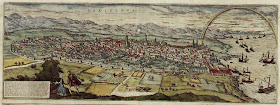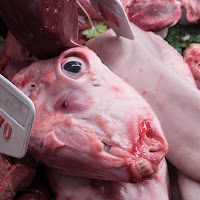In my last post I raved so much about Gaudi’s exuberant
architecture that it seems only fair to give the Old City it’s due this week. I
was really surprised by the older quarters of the city (Ciutat Vella in Catalan) primarily because I hadn’t
expected so much to remain. What I hadn't realized was that the entire city of Barcelona had been confined within high stone walls until 1859. This undoubtedly accounts for the cohesiveness of the Old City where there are blocks and blocks of narrow, twisty
streets lined with three and four story, balconied buildings. Some have lavishly painted facades, others are decorated with Gothic details, and all are nearly impossible to
photograph. This contrast between the old quarter and the (relatively) new areas makes
Barcelona a fascinating study in architectural styles.
The Old City is made up of three different neighborhoods, the
Barri Gotic (Gothic Quarter), La Ribera to the east and El Raval to the west. Each
has it’s own distinct style and contains an infinite number of architectural
treasures, ranging from Roman ruins to medieval churches and palaces, and Renaissance government buildings.
 |
| Map showing the extent of the walled city in the 18th century. The strong diagonal line is the avenue La Rambla. The Gothic quarter and La Ribera are to the right, and El Raval to the left. |
What is now the Placa de Sant Jaume in the Gothic Quarter was originally the center of
the Roman city of Barcino. This Placa is home to two of the
city’s most important government buildings, the Renaissance Palau de la
Generalitat (the seat of the Catalan government) and the Gothic Ajuntament (or
City Hall). Around the corner is Barcelona's Cathedrale de la Santa Creu i Santa
Eulalia which despite a 19th-century façade, was begun in 1298.
 |
| 15th Cetury Palau de la Generalitat |
The Gothic Quarter, particularly those streets nearest the
port, is also where Picasso spent his teen years. The Picasso Museum, located nearby in the La Ribera section, documents his meteoric rise. The works
are housed in five Gothic palaces that can be explored along with his art.
La Ribera also contains the Church of Santa Maria del Mar. Consecrated in 1384, this gem of the Catalan Gothic style owes its unusually cohesive appearance to the fact that it was constructed in a mere 55 years, an unprecedented feat for a Gothic cathedral.
Separated from the Gothic Quarter by the broad avenue La
Rambla (notorious haunt of pickpockets and thieves) is El Raval. Known since the early 20th century as 'Chinatown', a slang term for red light district, this area was notorious for
crime and prostitution, but is gradually becoming gentrified. The lively
Mercat de la Boqueria is located here. Originally a meat market (boqueria means ‘butcher’ in Catalan), fruit
and vegetable stalls were finally allowed to open in 1861. Now almost anything
edible can be found in this enormous building, constructed in 1914.
While these areas certainly aren’t as exuberant as the newer districts, nonetheless they’re a constant surprise. You turn a corner only to find an
arcaded building right out of the middle ages. You turn the next corner to find
yourself in a small square centered on a Gothic church. It’s all really well
preserved but doesn’t have that awful Disneyesque feeling that you get in some heavily
visited historic areas. Locals still live and shop here, there’s a lot of
graffiti and certain sections feel a little edgy. I only hope that as real
estate prices rise, these areas won’t lose their grit, their vitality or their veracity.













No comments:
Post a Comment